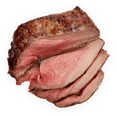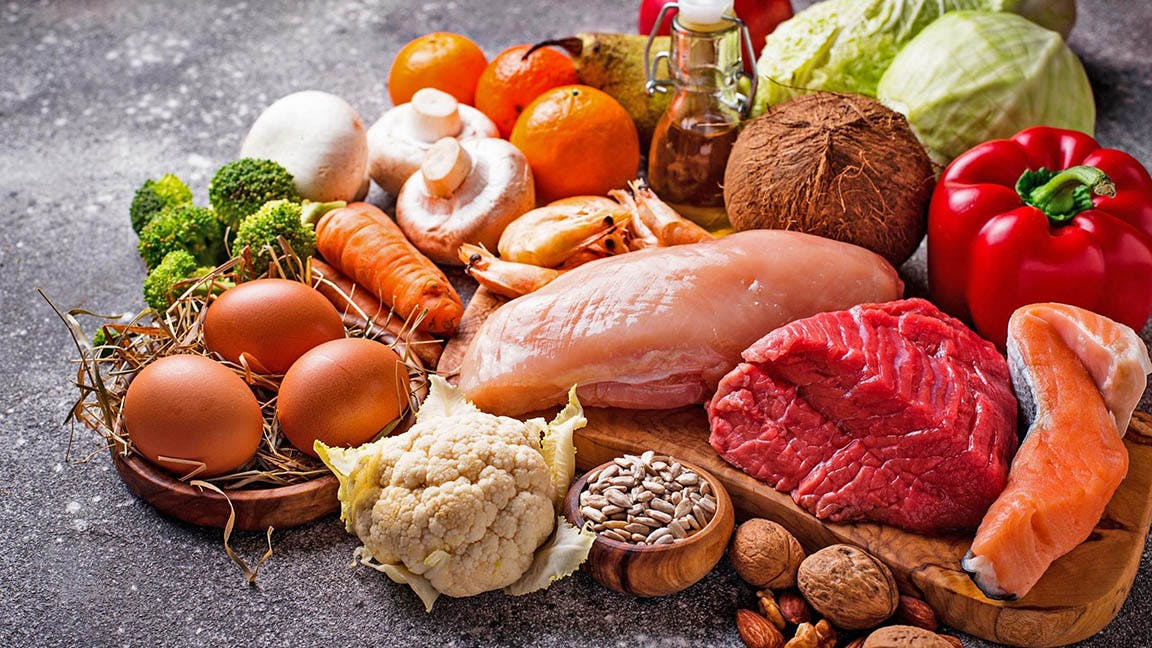What is a Paleo Diet?
We explain the Paleo diet, the foods you can and can't eat, and the pros and cons of eating Paleo.
 Back
Back






We explain the Paleo diet, the foods you can and can't eat, and the pros and cons of eating Paleo.

Processed foods are full of salt, sugar, and other artificial ingredients to make them look more appealing or mask the taste of other chemical ingredients. Those looking for a more natural, whole-foods-based diet may stumble across the Paleo diet. What is Paleo, and how is it different from other diets?
Paleo is short for paleolithic, representing the central idea of the Paleo diet and lifestyle. It is a return to the diet of our ancient ancestors. It is the ultimate ‘back to basics’ diet in that it rejects modern foods, which are often highly processed and additives. The Paleo diet suggests returning to a diet with plenty of meat, vegetables, and nuts.
What is now known as the Paleo diet first came when Walter L Voegtlin published his book, The Stone Age Diet, in 1975. Since then, the Paleo diet concept has been expanded upon and taken in a few different directions, but they generally all follow the idea of what is known as the discordance hypothesis. This suggests that the human body is ill-suited to the modern diet that developed when humans switched food sources from foraging to farming. Foods such as grains, legumes, and dairy products that emerged following the switch to farming are discouraged due to the idea that the human body has simply not had enough time to adapt to them.
Farming emerged around 10,000-12,000 years ago, a comparatively short time on an evolutionary scale, and therefore our digestive systems are unused to the foods that result from it. Not everyone slavishly follows rigorous rules on what is allowed and what isn’t. Some people are fine eating a baked potato or bowl of white rice now and again, while others will not touch butter or eggs no matter what. What is emphasized with a Paleo diet is whole, unprocessed, and nutrient-dense foods.
Much of a paleolithic diet is based upon foods that would have been accessible to our hunter-gatherer ancestors. There is an emphasis on eating lots of meat, particularly red meat, though it is a mistake to believe meat is the only thing consumed as part of a paleolithic diet. Many fresh vegetables, nuts, and some fruits are also encouraged.
Since our ancestors would have been foragers rather than farmers so many of the foods recommended as part of a paleo diet were available in some form in the natural environment around them. These are typically fresh, nutrient-rich, ‘whole foods.’ Examples of recommended foods to eat include:
● Meat - boneless, skinless chicken breasts, beef, lamb, sugar & nitrate-free bacon, pork, extra-lean ground turkey
● Fish - wild-caught sockeye salmon, wild-caught Icelandic cod, tuna
● Fruits
● Vegetables
● Nuts and seeds
● Eggs
● Minimally processed oils - extra virgin olive oil, flaxseed, walnut, avocado, coconut
It’s encouraged to try to source ingredients that closely match what our ancestors would have had available to them. So, when choosing meat, opt for meats that are grass-fed or free-range meats wherever possible. When selecting fish, go for wild-caught ones high in omega-3 fatty acids. These are more ethical choices, but they are typically more nutrient-rich as well.
A paleolithic diet rejects modern, processed foods. The belief that our digestive systems have not had sufficient time to evolve and adapt to many of the foods introduced with farming and agriculture discourages the consumption of foods high in carbs and refined sugars. These include foods such as:
● Bread
● Cakes
● Pasta
● Cereals
● Rice
● Highly sophisticated seed and vegetable oils
● Salt
● Dairy products
● Legumes (e.g., beans, peanuts, peas, and lentils)
● Potatoes
The above-listed foods would have been difficult, if not impossible, for our ancient ancestors to acquire and are believed to put a strain on the digestive system. Many of these foods also contain a lot of artificial chemical additives in the form of preservatives, colorings, and flavorings that aren’t present in whole foods.
Many followers of a Paleo diet emphasize only eating whole foods, so it would be helpful to define what whole food is and isn’t. It helps in general terms to remind yourself of the basic idea of the Paleo diet. It is intended to closely match the sort of diet our ancient ancestors would eat. Thus, try to imagine what they would have had available to them.
Whole foods have minimal or no processing. You eat it ‘whole’ without modifications. A cut of meat, a fillet of fish, nuts, seeds, and freshly picked vegetables (ideally grown and harvested without pesticides) are examples of whole foods. Naturally, you will need to cook some of these foods, but otherwise, they should be as close as possible.
Highly processed and refined foods are not whole foods. Beer is an excellent example of a nonwhole food because it requires a lot of processing to convert hops and grains into beer.
Likewise, foods grown with pesticides and chemical additives are considered non-whole foods.
Paleo de-emphasizes eating carbs and encourages the consumption of proteins and fats. There was a myth in dietary circles in the ‘80s that fats are bad for you. Perhaps this is because of the belief that eating a lot of fat would make you fat. However, modern research suggests that fats aren’t bad for you. Much of what was blamed on fats is caused by sugar and other highly refined carbs - foods discouraged on a Paleo diet.
It’s essential to recognize that not all fats are created equal. There are many different types of fats, such as saturated fats, unsaturated fats, and trans fats. Trans fats are by far the worst type of fats for your health, and these are produced by adding hydrogen to unsaturated fats - an artificial process and something discouraged in a Paleo diet.
On the other hand, unsaturated fats such as omega-3 fatty acids are essential for your health they cannot be made by the body but are required for various physiological functions. These fats are found in foods like salmon, tuna, walnuts, flaxseed oil, and more - all the kinds of fats encouraged on Paleo diets.
On a slightly less scientific note, fats also help you feel full. If you feel full quicker, you’re less likely to feel the urge to snack and, therefore, should find it easier to stick to your set meals.
Paleo has become a trendy diet and lifestyle, with many followers extolling the benefits of its clean, nutrient-rich, whole foods-focused diet. Nevertheless, it is not without its controversies. Below are some of the pros and cons followers and critics make of the Paleo diet.
Pros
● It emphasizes eating fresh, nutrient-rich foods with no artificial ingredients.
● It discourages many unhealthy additives such as salt, sugar, and chemical preservatives.
● It encourages ethical meat sourcing, such as free-range, grass-fed, and wild-caught meats.
Cons
● Some foods it discourages, such as whole grains and legumes, are beneficial to cardiovascular health.
● We don’t fully understand all aspects of a Paleolithic human diets, leading to many claims being based on assumptions rather than hard evidence.
● The idea that the human body has not been able to adapt to certain foods is controversial, primarily due to how varied the human diet is worldwide, both now and in ancient times.
Whether you agree with the rationale behind the Paleo diet, the emphasis on eating fresh, minimally processed meats, fruits, and vegetables is generally in agreement with contemporary nutritionists. It’s also not an exceptionally restrictive diet in that you don’t need any complicated systems of points per foodstuff or calorie counting. It’s mostly about cutting down on foods high in sugars, salt, and artificial ingredients. All good advice, whether you believe our ancestors would have eaten these foods if available to them or if our digestive systems can adapt to these foods or not.
Posted on August 10th, 2023